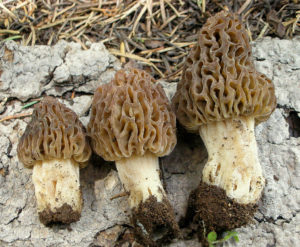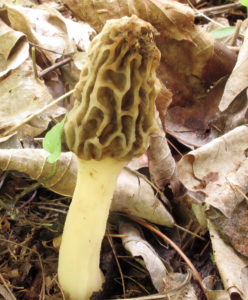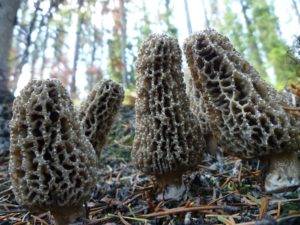For many, Morels are the edible wild mushrooms.
Morels[i] have their share of nicknames, of course, including molly moocher and hickory chickens, but in certain circles no name is necessary; “mushroom” means “morel.” They are that good to eat. The fact that they are easy to identify but difficult to find wild—and difficult to cultivate—simply adds to the mystique of the exotic morel.
Scientifically, morels[ii] are the members of the Morchella genus. They belong to the same family as the Verpas, with which they can sometimes be confused. Despite the existence of numerous “false morel” groups, true morels are relatively easy to recognize because they have a very distinctive look. Identifying morels to species—or even figuring out how many species there are—is harder, though, since morel species can be extremely variable. No matter how many or how few species there are, though, there are morels of one kind or another across much of the world.

My name is Austin Collins.
I've dedicated my life to Mushrooms.
I believe Mushrooms are the best kept secret when it comes to health and well being.
For that reason, I would like to share a company with you that in my opinion makes the best mushroom products on the market.
The company is called Noomadic Herbals, my favorite supplement they make is called "Mushroom Total".
I take their products every day and they have helped me think better and have more energy. Give them a try.
-Austin
Morel Mushroom Identification and Description
In general, morels are shaped like bells—a long, narrow cap that hangs down around the stem, like a bell around its clapper. Unlike in some of the false morels, the cap is fused to the stem for part or all of its length. The stem is always hollow, without any cottony tissue inside, and usually quite short. There are no gills or pores. Instead, spores are released from the outer surface of the cap, which has a pitted, honeycomb-like structure. Color and size vary both within species and between species.
Morels can be mycorhizal (growing in partnership with tree roots) or they can feed off of dead plant matter, or both. The details of where and how they grow (and thus where and when they can be found) vary, but they always fruit from the ground, never from logs or stumps. Morel season is usually in the spring, but whether a given fungal individual will choose to fruit in a particular year is very hard to predict—even good morel spots (the locations of which can be closely-guarded secrets) are not reliable[iii].
Several types of morels are familiar to mushroom hunters, commercial suppliers, and users of certain field guides. These include yellow morels, black morels, gray morels, and greenies. Unfortunately, these names don’t correspond to species as defined by mycologists. For one thing, some of the common names are used differently by suppliers operating in different areas. For another, age and individual variation mean that several species have multiple distinct “looks,” and these have long been mistaken for separate species.
The following list is far from complete but includes many of the currently-recognized North American species. It should give the reader a sense of the diversity of the morel group[iv].
List of Popular Morel Mushrooms
Morchella snyderi

Cap: small. Yellow, black, or yellow and black, depending on age. The pits are elongated vertically.
Stem: whitish to pale brown, developing ridges and holes with age
Habitat: fruits under conifers. One of the very few morels in Western North America that fruits in wild settings without being preceded by a forest fire.
Morchella frustrata

Cap: medium-size, usually cone-shaped. Yellowish to tan, but otherwise resembling species of the black morel group; the pits are elongated vertically, and there is a groove where the stem meets the cap.
Stem: whitish, smooth or grainy.
Habitat: fruits under either hardwoods or conifers.
Morchella diminutiva

Cap: very small, narrow, yellowish to brownish. The pits are usually, but not always, elongated vertically, and there is no groove where the stem meets the cap.
Stem: whitish, sometimes longer than the cap is, smooth or grainy.
Spore color: orange-yellow
Habitat: fruits under a variety of hardwoods.
Morchella esculentoides

Cap: medium to large, usually egg-shaped but sometimes round or irregular, pits either not elongated or elongated in random directions, no grove where the stem meets the cap. Usually yellowish with somewhat darker pits, but can vary a lot based on age and other factors.
Stem: whitish, yellowish, or brownish, sometimes quite long and with a very thick base. Smooth or grainy.
Habitat: fruits under a variety of hardwoods, but preferences vary widely from one region to another.
Note that although M. esculentoides is very widely distributed across North America, and thus familiar to most morel hunters, there is a region from the central and northern Appalachians into the Midwest where it shares its range with M. cryptica. The two species look exactly alike in all ways, though they differ genetically and may also have slightly different habitat requirements.
Morchella tomentosa

Cap: medium-sized, egg-shaped to conical, covered in fuzz especially when young. Dark gray when young, but color is very variable at maturity. The pits start out round and densely-packed, but get stretched vertically with age.
Stem: very dark when young but becoming pale with age. The base is usually swollen. Fuzzy, at least in patches.
Habitat: fruits under conifers, but usually only in the spring after a forest fire, or sometimes for the first several springs after a fire.
Morchella angusticeps

Cap: medium-sized, conical or occasionally egg-shaped, with a groove where the cap meets the stem. Slightly fuzzy, especially when young. The ridges between the pits become black with age. The pits themselves are elongated vertically.
Stem: whitish to pale brown, smooth or grainy, developing wrinkles with age, especially in wet conditions, when the stem may also swell.
Habitat: fruits under a variety of hardwoods.
Note that this species is very distinctive across most of its range, North America east of the Rockies—but there is a morel in the far northern part of its range from which it differs only subtly.
Morchella populiphila

Cap: smallish, more or less conical, pits elongated vertically. Unlike in most morels, the lower half of the cap is not fused to the stem. The ridges are brown in young specimens but blacken with age and are darker than the pits.
Stem: whitish to pale brown, smooth or grainy, sometimes with dark speckles. May become much longer than the cap with age.
Habitat: fruits under black cottonwood trees west of the Rocky Mountains.
Note that this is one of North America’s two “half-free” morels, the other being M. punctipes. A third half-free grows in Europe. The American half-frees look almost indistinguishable, but don’t share any part of their range. The eastern half-free also has much broader habitat preferences.
Morchella rufobrunnea

Cap: large, usually conical, and curiously pointed and twisted when young. When young, the pits are dark and the ridges are white, or nearly so, but the entire cap turns yellow with age. Bruises reddish when handled.
Stem: whitish to pale brown or yellow, bruising reddish when handled, smooth or grainy. Sometimes swollen at the base. Mostly short.
Spore color: pale orange to yellowish.
Habitat: fruits in disturbed areas, including roadsides, gardens, and landscaping sites.
Note that this species is remarkable for two reasons. First, this is the cultivated species. Its ability to live solely on dead plant matter for its entire life cycle is highly unusual (though not unique) among morels and is the trait that allows this species, but not most others, to be cultivated. Second, genetic studies show that this is the species from which all other morels evolved, tens of millions of years ago.
Morchella capitata, Morchella sextelata, Morchella septimelata
These three species are all quite similar, having both conical to round caps that are dark brown, blackish, or greenish, and a definite habit of fruiting after forest fires. They are not identical, but their differences are subtle and not well-documented. M. capitata is unusual among the group in having thin layers of tissue inside the otherwise hollow stem.
Morel Mushroom Look-Alikes
There are several groups whose members can sometimes be confused with morels by the unwary.
These are the aptly-named false morels, which have wrinkled rather than pitted caps, and the early morels, or Verpas, which have wrinkles caps and much longer stems. The resemblance is notable but hardly exact. Some stinkhorns are referred to as morels in some older books, and without the slime layer would resemble morels except for having a longer stem, but usually at least a trace of slime remains. Occasionally, false morels or early morels are sold as morels, unfortunately.
It’s not difficult to separate out the true morels from their look-alikes, as long as the forager (or shopper) pays attention. The real problem with the false morels (and the early morels, to a lesser extent) is that their toxicity is a matter of real debate; false morels are seldom eaten by mistake but, rather, on purpose. Some people like false and early morels. And some of those people get sick or even die, while others have no trouble.
Warnings and Toxicity
Although morels are widely and enthusiastically eaten, and many writers confidently assert that there are no poisonous morels, a very small portion of people do get sick after eating morels[v]. Not much is known about the problem, but it does not appear to be an allergy (multiple people who eat the same meal get sick), nor are these cases of mistaken identity. Raw morels seem to present more of a risk and should not be eaten, but well-cooked morels have caused illness as well. Again, very little is known.
In all cases, the symptoms have gone away on their own.
Hunting, Harvesting, and Eating Morels
Morels are reputed to have some medicinal benefits[vi], and they are healthy to eat (but see the warning above!), but they are best known for their rich, earthy taste. Though taste and texture vary slightly, the various morel species are usually treated interchangeably by cooks.
Morels[vii] can be cooked any number of ways. Browning enhances the flavor. Since they are hollow, it’s worth checking the inside for bugs or dirt. Contrary to much folk wisdom, they should not be soaked in salt water prior to cooking—it ruins both the taste and texture. Morels also dry easily for convenient longer-term storage.
Hunting morels for personal use is a popular hobby, and hunting them for commercial sale can be quite profitable. In theory, collecting mushrooms is a sustainable activity, since the fungal organism itself isn’t damaged; picking mushrooms has been compared to picking apples, in that respect. However, if every single mushroom were picked, the fungus would not be able to reproduce. It’s also possible there could be environmental impacts from large numbers of mushroom hunters moving through an area. Because it’s not clear how many morel hunters there are, and because there is a lot about morel biology and ecology that still isn’t known, it’s hard to say whether the current harvest is sustainable.
If you’re interested in collecting Morel Mushrooms be sure to pick up a Mushroom Field Guide or Book to help with identification.
It’s almost as difficult to advise anyone on how to hunt morels. Most species fruit in the spring, but where they might fruit depends on the species—or even the region, since some species have different preferences in different areas. And even tried-and-true morel spots don’t produce every year. Although some species are known to fruit after forest fires or after other disturbances, in many cases the trigger for fruiting isn’t known.
It’s also possible to purchase fresh morels in some farmers’ markets and specialty grocery stores, in areas where morels grow readily. In other areas getting fresh ones might not be possible, but specialty grocery stores, including some “health food” stores, may have dried morels. Most commercially available morels were wild-gathered, since cultivation is not yet well-established.
It is possible to grow morels at home, though growing them indoors requires specialized equipment and knowledge. Mushroom Grow kits are available, but these are typically packets of spores with detailed instructions for outdoor cultivation[viii], not pre-inoculated growth medium as in the kits for, say, oysters. It’s also possible to dispense with the kits, build a garden with suitable habitat, and inoculate the garden using a slurry made from fresh morels. Results can be hit or miss in either case (among other issues, open-air gardens can get weeds, meaning that mushrooms of other, perhaps not edible, species may also come up), and morels can take several years to fruit. Those starting with home-made slurry should remember that not all morel species share the same habitat requirements; if the mushroom used as “seed” is not of the right species for the garden, the project won’t succeed.
That being said, morel gardening can sometimes work brilliantly.
References:
[i] Bourjaily, P. (2013). A Beginner’s Guide to Hunting Morel Mushrooms.
[ii] Kuo, M. (2012). True Morels and Verpas.
[iii] Volk, T. (n.d.). The Morel Life Cycle.
[iv] Kuo, M. (2012). True Morels and Verpas.
[v] Benjamin, D.R. (2015). Neurological Effects of Mochella sp. FUNGI 8 (3): 25.
[vi] Tietel, Z., Masaphy, S. (2018). True Morels (Morchella)–Nutritional and Phytochemical Composition, Health Benefits, and Flavor: A Review. Critical Reviews in Food Science and Nutrition 58(11): 1888-1901.
[vii] Bergo, A. (n.d.). Morel Mushrooms
[viii] Fanello, S. (n.d.). The Top 3 Morel Mushroom Grow Kits.




Thank you so much for sharing your knowledge. Morels are a special favorite of mine too, though ALL mushrooms fascinate me. I recently purchased 3.94 acres of wooded land in southern Missouri & am anticipating foraging this spring. The knowledge you shared will be useful in my searches!